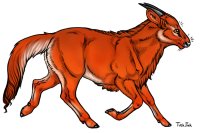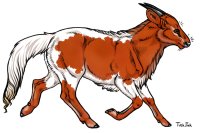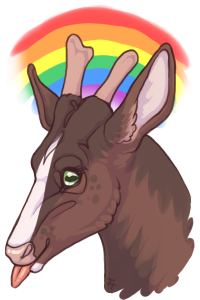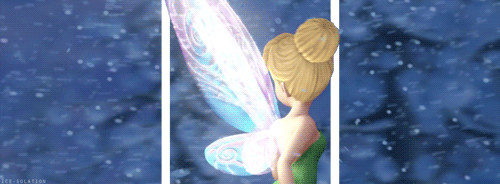Forum rules
Reminder: Copying another person's art without permission to reproduce their work is a form of art-theft!Click here to see the full Art Rules!
 by tikki-tak » Sat Apr 18, 2015 5:13 pm
by tikki-tak » Sat Apr 18, 2015 5:13 pm
 Artist Search
Artist Search -
Nursery -
Customs -
Additional Species Information -
Fanclub -
ArchivesAnnouncementsCheck out the Summer Event for new mutations and the opportunity to earn custom Dusa!

"Dusa" is the name for any of 5 similar species in the closely-related genus Dusa. They are small antelopes, closely related to the Duikers, but they have several distinct characteristics which make them unique among bovids. The greatest difference of all is their diet - all species of Dusa are nearly exclusively carnivorous. They are notoriously difficult to keep in captivity due to their shy nature and strong social bonds, and very few captive packs have been established - until now. A sustainable captive population of Dusa dusa, known as the Striped Dusa or Common Dusa, has been established, and are ready to be adopted out. And who knows - there may even be other Dusa species hidden away within the pack.

Adoption Rules
All Dusa with a coloured background and/or an "Adopt Me!" sign are available for adoption.
You may own as many Dusa as you can care for.
You may only adopt one Dusa every 2 days.
Dusa are a closed species, therefor you cannot make your own.
You may not sell your Dusa for currency, but gifting is allowed. (please let the archivist know ahead of time)
Dusa breedings depend on the social rank and species of your Dusa - for more information, please visit the breeding thread.
Any member (artists included) may enter adoption contests.
You may not request customs. They are only available for artists, during events, or if an artist offers.
Please be polite.

Last edited by
tikki-tak on Tue Jun 23, 2015 8:59 am, edited 11 times in total.
-
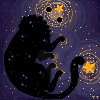
tikki-tak
-
- Posts: 514
- Joined: Sun Feb 08, 2015 4:04 pm
- My pets
- My items
- My wishlist
- My gallery
- My scenes
- My dressups
- Trade with me
 by tikki-tak » Sat Apr 18, 2015 5:17 pm
by tikki-tak » Sat Apr 18, 2015 5:17 pm

Anatomy wrote:Dusa are small, partially-hoofed carnivorous bovid. Adults of most species stand between 50-70cm high at the shoulder and weigh on average 20-30kg, with females often being slightly larger than males. Both sexes have a pair of short, backwards-facing horns. Other than the very small difference in size, Dusa show very little sexual dimorphism, and it is very hard to tell the sexes apart in the field by appearance alone.
Dusa have many adaptations to fit their carnivorous lifestyle: they are bulky and heavy-set compared to most antelope, due to the strain of hunting. They have also lost much of their hoof mass, instead having fleshy pads with small "hooflets", which makes it easier for the Dusa to stalk their prey, while the hooflets provide excellent traction while running. Their long, muscular tails act like a counterbalance, allowing them to make harp turns at high speeds, and, unique to all other species of bovids, Dusa possess upper front teeth and canines, as well as shearing teeth.

Hunting and Diet wrote:Dusa are almost exclusively carnivorous, hunting in packs. They most often feed off of small animals such as rabbits, birds or rodents, but working as a team will often bring down larger game such as small deer or antelope.
Dusa will occasionally eat fruit or nuts if they are hungry enough, and have been documented eating leaves, grass and even bark in times of extreme famine.

Pack Structure wrote:Dusa live in small packs, usually with between 2-10 individuals. They are matriarchal, with a dominant female leading the group, several (usually related) females, and a few unrelated males. Females usually stay in their birth pack for their entire lives, while males usually leave their birth pack between the ages of 2-4 years, as they reach maturity.
Dusa packs are organized in a loose hierarchical structure, with females and males ranking in separate systems. Dusa are highly matriarchal, with all females being higher in rank than any male. In some species, or even individual packs, these hierarchies may not be enforced as severely. However, a dominant female is always present.

Reproduction wrote:A typical litter contains 1-3 young, which will nurse for around 6 months. Dusa fawns are lighter than the adults, with a spotted coats.
In times where food is not readily available, only the dominant female will have fawns. She will not allow any other members to do so. In times of plenty, however, any member of the pack will be allowed to breed, though the arrival of fawns will often be staggered throughout the season.
Dusa are semi-monogamous, forming pairs that may last several breeding seasons. Rarely, they may stay with one mate their entire lives, or even take a multiple mates in a season. All pack members help to take care of fawns.
Female Dusa reach maturity at around 2 years old, males at 3 years old. Dusa usually live between 15-20 years in the wild, though some captive Dusa have reportedly reached ages of 25 years or more.

Captive Dusa & Humans wrote: Though wild Dusa are incredibly shy and very wary of humans, their captive counterparts can be handled with relative ease if socialized properly. It takes a lot of time, effort and experience to gain the trust of a Dusa, but the rewards are many. Though they will never be as affectionate as domestic animals such as dogs or horses, Dusa can and will form a relationship with humans that they have regular contact with. However, they are usually still very wary of strangers. This, coupled with their territorial nature, makes them excellent guard animals.
They can also be used for hunting and tracking, and though they are far too small to ride, they can sometimes be trained in harness.
Dusa should be kept in groups of at least two animals if possible, as they are highly social animals and can become depressed, anxious and/or aggressive if kept alone for too long.

Last edited by
tikki-tak on Tue Jun 23, 2015 11:26 am, edited 6 times in total.
-

tikki-tak
-
- Posts: 514
- Joined: Sun Feb 08, 2015 4:04 pm
- My pets
- My items
- My wishlist
- My gallery
- My scenes
- My dressups
- Trade with me
 by tikki-tak » Sat Apr 18, 2015 5:21 pm
by tikki-tak » Sat Apr 18, 2015 5:21 pm

Common Dusa
Dusa Dusa
This medium-sized Dusa is the most commonly found Dusa in captivity. In the wild, they have a striped coat with pale legs, belly and face markings, as well as a white rump patch and underside of tail. Their tails are long and muscular, with longer hair near the end. They have a medium-length coat, and a short mane running along the top of their neck and back, as well as down their chest. Their pack structures are relatively organized, with a few dominant females being recognized, and males having a somewhat looser hierarchical structure of their own. They are usually fairly calm, and adapt easily to new environments and social structures. They can be kept easily with any other species of Dusa.
They make excellent guard animals, and can also be trained in harness or agility.
Their natural coat colour is Wild Agouti (A+) which is dominant over all other forms of Agouti.

Siberian Dusa
Dusa pacificus aquilonem
This very large subspecies of the Pacific Dusa is hard to find in captivity. In the wild, they are dark in colour, with paler extremities and facial markings. The underside of the tail, as well as the ends of their long mane hair and feathering, is often pale as well. They have an extremely long, thick coat, which is usually wavy in appearance. This also applies to their tail and manes. The pack organization of the Siberian Dusa is much stricter than that of the Common Dusa, and all member have a distinct rank in the pack hierarchy. They can be more aggressive than other species of Dusa, and since they are much larger, will often assume a dominant role in a mixed-species pack. They can be kept with Common Dusa, but may bully Sable Dusa if they are kept together, because of the differences in size and social norms. They can breed with Common Dusa, but it is unsafe to breed them with Sable Dusa. Pure Siberian Dusa will pass on the long coat and thick horns 100% of the time, while Siberian Dusa hybrids will only pass on the coat or horns 50% of the time when bred to Common Dusa.
They make excellent guard or harness animals, and their long, soft coat makes them an excellent wool animal. They may need to be clipped in the summer months.
Their natural coat colour is Siberian Agouti (As) which is hidden by Wild Agouti (A+) but dominant over all other forms of Agouti.

Sable Dusa
Dusa vivis
This desert-dwelling Dusa is the smallest species of Dusa, and very rare. In the wild, they are a pale tan, with dark spots along the top of the body, and a striped tail. They have pale markings on the face and legs, as well as the underside of the tail. They are desert-adapted, with large ears and a short, fine coat. They have a short, stiff mane running along the neck and back, but no long hair along the chest or belly. Their tail lacks the long hairs of the Common Dusa. These Dusa are very shy and docile, and have a very loose pack organization, with only one dominant female being recognized. This, along with their small size, often causes them to assume a submissive role in mixed-species packs. They can be kept in small packs with Common Dusa, but may be harassed and become stressed when put with Siberian Dusa. Sable Dusa can breed with Common Dusa, but it is unsafe to breed them with Siberian Dusa. Pure Sable Dusa will only pass on their short coat and horns when bred with other Sable Dusa, or Sable Dusa/Common Dusa Hybrid. When a Sable Dusa/Common Dusa Hybrid is bred with another Sable Dusa or Sable Dusa Hybrid, there is a 50% chance of the coat and/or horns passing down to offspring.
They are too shy to make good guard animals, but make excellent companion animals if socialized properly. They also preform well in light harness, agility, and racing.
Their natural coat colour is Sable Agouti (Av) which is hidden by Siberian Agouti (As) and Wild Agouti (A+) but is dominant over all other forms of Agouti.

Last edited by
tikki-tak on Tue May 05, 2015 2:35 am, edited 1 time in total.
-

tikki-tak
-
- Posts: 514
- Joined: Sun Feb 08, 2015 4:04 pm
- My pets
- My items
- My wishlist
- My gallery
- My scenes
- My dressups
- Trade with me
 by tawnypelt3 » Sat Apr 18, 2015 5:22 pm
by tawnypelt3 » Sat Apr 18, 2015 5:22 pm
I'm sorry but that's too cute to be legal. I will have to citizen's arrest you.
I was hacked. Not going to remake all my groups and such unless I feel like it. That's a lotta work. Don't bother with trades, everything's a mess.
Need:

Will offer
reasonable overpay.
.Note to self:
Reduce idiot level.

-

tawnypelt3
-
- Posts: 14358
- Joined: Tue Apr 07, 2009 10:08 am
- My pets
- My items
- My wishlist
- My gallery
- My scenes
- My dressups
- Trade with me
Who is online
Users browsing this forum: No registered users and 11 guests









